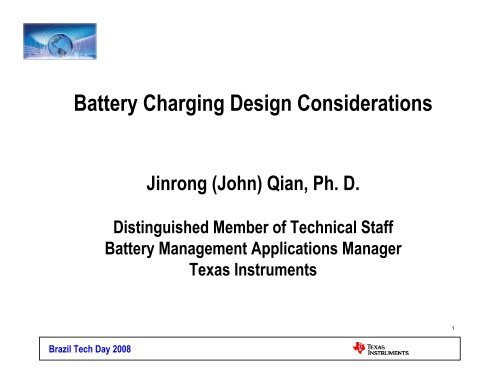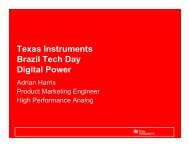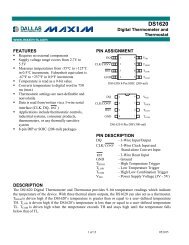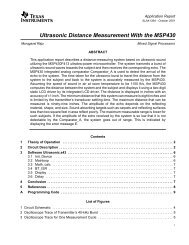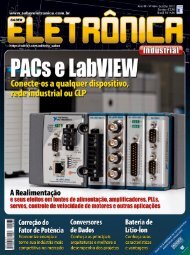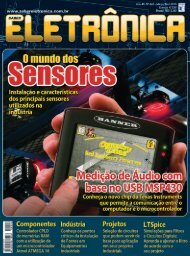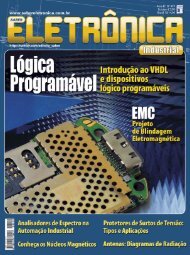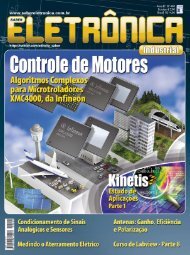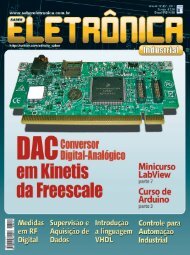Brazil Tech Day 2008 - Portal Texas Instruments - Brasil
Brazil Tech Day 2008 - Portal Texas Instruments - Brasil
Brazil Tech Day 2008 - Portal Texas Instruments - Brasil
You also want an ePaper? Increase the reach of your titles
YUMPU automatically turns print PDFs into web optimized ePapers that Google loves.
Battery Charging Design Considerations<br />
<strong>Brazil</strong> <strong>Tech</strong> <strong>Day</strong> <strong>2008</strong><br />
Jinrong (John) Qian, Ph. D.<br />
Distinguished Member of <strong>Tech</strong>nical Staff<br />
Battery Management Applications Manager<br />
<strong>Texas</strong> <strong>Instruments</strong><br />
1
<strong>Brazil</strong> <strong>Tech</strong> <strong>Day</strong> <strong>2008</strong><br />
Longer<br />
Battery Life<br />
Smaller Size<br />
& Weight<br />
Battery Power Management<br />
Safety (bq26100)<br />
Longer cycle life and runtime<br />
Faster and cooler charging<br />
Smaller size and lighter weight<br />
2
<strong>Brazil</strong> <strong>Tech</strong> <strong>Day</strong> <strong>2008</strong><br />
Agenda<br />
• Li-Ion Battery Characteristics and Charging Requirements<br />
• Battery Charging Front-End (CFE) Protector<br />
• Power Path Management Battery Charger<br />
• 3MHz switching mode USB battery charger<br />
• Low EMI 1-2A Synchronous Switching Li-Ion Battery Charger<br />
• 1-4 Cell Li-Ion battery switching charge controller<br />
• Summary<br />
3
<strong>Brazil</strong> <strong>Tech</strong> <strong>Day</strong> <strong>2008</strong><br />
Battery Chemistries<br />
• Primary battery: Non-rechargeable (Alkaline)<br />
• Secondary battery: Rechargeable<br />
• NiCd: 1.0V to 1.5V<br />
• NiMH: 1.0V to 1.5V<br />
• Li-Ion<br />
LiCoO2 - Coke: 3.0V to 4.1V<br />
LiCoO2 - Graphite: 3.0V to 4.2V<br />
LiMnO4 - Graphite: 3.0V to 4.4V<br />
LiFePO4 - Graphite: 2.0V to 3.6V<br />
4
<strong>Brazil</strong> <strong>Tech</strong> <strong>Day</strong> <strong>2008</strong><br />
NiMH Battery Charge Characteristics<br />
dT<br />
dt<br />
-∆V<br />
1 C<br />
0.5 C<br />
• Constant current<br />
• Cell voltage drop<br />
• Cell temperature Increase<br />
• Charge termination: -∆V, dT/dt, safety timer<br />
0.1 C<br />
1 C<br />
0.5 C 0.1 C<br />
C BAT R BAT<br />
5
1200<br />
1000<br />
800<br />
600<br />
400<br />
200<br />
0<br />
<strong>Brazil</strong> <strong>Tech</strong> <strong>Day</strong> <strong>2008</strong><br />
NiMH Self-Discharge Characteristics<br />
Capacity mAh<br />
45 0 C<br />
0 10 20 30 40 50 60 70<br />
Time: <strong>Day</strong>s<br />
• Self-Discharge 2.5%/day at 25C<br />
• Higher T, Higher Self-discharge<br />
15 0 C<br />
25 0 C<br />
35 0 C<br />
6
<strong>Brazil</strong> <strong>Tech</strong> <strong>Day</strong> <strong>2008</strong><br />
Advantages and Limitations: NiMH Battery<br />
Advantages:<br />
• Fast and simple charge: constant current charge<br />
• 50-100% more capacity/energy than NiCd<br />
• No transportation regulation<br />
• Lower cost than Li-Ion, but 20% more expensive than NiCd<br />
Disadvantages<br />
• High self-discharge at high temperature (30% per month)<br />
• Voltage depression. Cathode material changes into inactive crystalline<br />
form when stored in charged state.<br />
• Prevention – discharge regularly.<br />
• Repair: Charge/discharge several times to 0.7V. For cases of severe<br />
capacity loss, keep at 0.7V for prolonged time (24 hrs)<br />
7
Performance<br />
bq2002<br />
<strong>Brazil</strong> <strong>Tech</strong> <strong>Day</strong> <strong>2008</strong><br />
NiMH/NiCd Battery Charger<br />
bq24400<br />
bq2000<br />
bq2005<br />
bq2004<br />
• Simple switching charge controller<br />
• Termination: PVD, ∆T/ ∆t<br />
• Integrated closed loop current control<br />
• Low-cost charger termination controller<br />
• Termination: PVD, -∆V, ∆T/ ∆t<br />
• Controls current-limited or constant current supply<br />
Cost<br />
• Sequential fast charge of 2<br />
battery packs<br />
• Discharge-before-charge option<br />
• Termination: PVD, -∆V, ∆T/ ∆t<br />
• Dual LED status display<br />
• Charges NiCd/NiMH and Li-Ion<br />
• Termination: PVD, ∆T/ ∆t for NiCd/NiMH,<br />
minimum current for Li-Ion<br />
Switching<br />
Current-<br />
Limited<br />
8
<strong>Brazil</strong> <strong>Tech</strong> <strong>Day</strong> <strong>2008</strong><br />
Li-Ion Battery Characteristics and<br />
Charging Requirements<br />
9
Cell Capacity mAh<br />
3500<br />
3000<br />
2500<br />
2000<br />
1500<br />
1000<br />
500<br />
0<br />
• Source: TIAX LLC, Portable Power 2005 Li-Ion Battery Tutorial, and Boston Power, Florida battery seminar, 2007<br />
<strong>Brazil</strong> <strong>Tech</strong> <strong>Day</strong> <strong>2008</strong><br />
18650 Li-Ion Cell Capacity Development Trend<br />
1992 1994 1996 1998 2000 2002 2004 2006<br />
• 18650: Cylindrical, 65mm length, 18mm diameter<br />
• 8% yearly capacity increase over last 15 years<br />
• NB makers are using 2400mA, 2600mAh<br />
18650 Cell<br />
18mm<br />
65mm<br />
10
500<br />
450<br />
400<br />
350<br />
300<br />
250<br />
200<br />
150<br />
Wh/kg<br />
<strong>Brazil</strong> <strong>Tech</strong> <strong>Day</strong> <strong>2008</strong><br />
Energy Density Development for Li-Ion Cells<br />
Gravimetric Density<br />
100<br />
1994 1996 1998 2000 2002 2004 2006<br />
7%<br />
80<br />
6%<br />
Ali Madani, “An overview of the European Li-Ion battery R&D” Florida Battery seminar 2007<br />
200<br />
160<br />
120<br />
• 6-7% annual energy density increase<br />
40<br />
0<br />
Wh/L<br />
Volumetric Density<br />
1994 1996 1998 2000 2002 2004 2006<br />
11
Cathode<br />
+<br />
Positive<br />
electrode<br />
LiCoO 2<br />
<strong>Brazil</strong> <strong>Tech</strong> <strong>Day</strong> <strong>2008</strong><br />
Battery Electrical Equivalent Circuit<br />
Electrolyte<br />
Separator<br />
Battery AC model<br />
Anode<br />
-<br />
Negative<br />
electrode<br />
Graphite<br />
Constant current discharge,<br />
transient effect<br />
ON<br />
I . R BAT<br />
OFF<br />
Capacitor<br />
Capacitor + resistor<br />
Battery<br />
Battery DC model<br />
C BAT R BAT<br />
12
Voltage, V<br />
4.5<br />
4.0<br />
3.5<br />
3.0<br />
0<br />
Load current: 0.2C<br />
<strong>Brazil</strong> <strong>Tech</strong> <strong>Day</strong> <strong>2008</strong><br />
Battery Chemical Capacity<br />
3.6V (Battery rated voltage)<br />
EDV=3.0V/cell<br />
1 2 3 4 5 6<br />
Capacity, Ah Qmax Battery Capacity: 1C<br />
Discharge rate 1C:<br />
Current to completely discharge a<br />
battery in one hour<br />
Example:<br />
2200mAh battery,<br />
1C discharge rate: 2200mA, 1 hr<br />
0.5C rate: 1100mA, 2hrs<br />
C BAT R BAT<br />
• Battery capacity (Qmax) : Amount of charge can be extracted from the fully charged<br />
cell to the end of discharge voltage (EDV).<br />
• EDV is mini. voltage acceptable for the application or for battery chemistry<br />
13
Battery Voltage (V)<br />
4.2<br />
3.6<br />
3.0<br />
2.4<br />
EDV<br />
<strong>Brazil</strong> <strong>Tech</strong> <strong>Day</strong> <strong>2008</strong><br />
I•R BAT<br />
+ - I<br />
OCV RBAT + -<br />
Useable Capacity Quse<br />
V=OCV - I*R BAT<br />
Open Circuit Voltage<br />
(OCV)<br />
Quse<br />
Qmax<br />
• EDV will be reached earlier for higher discharge current.<br />
• Useable capacity Quse < Qmax Q use<br />
Q max<br />
14
<strong>Brazil</strong> <strong>Tech</strong> <strong>Day</strong> <strong>2008</strong><br />
Li-Ion 18650 Discharge Characteristics<br />
EDV<br />
ΔV1<br />
1/5C<br />
2C<br />
What’s battery DC impedance at SOC=50%?<br />
(3.8V-3.4V)/3A=130mΩ<br />
1C<br />
ΔV2<br />
ΔV = ΔI R BAT<br />
15
Li-Ion 18650 Temperature Discharge Profile<br />
Self-heat Effect (Internal impedance decrease when T increase)<br />
<strong>Brazil</strong> <strong>Tech</strong> <strong>Day</strong> <strong>2008</strong><br />
16
100<br />
80<br />
60<br />
40<br />
20<br />
0<br />
<strong>Brazil</strong> <strong>Tech</strong> <strong>Day</strong> <strong>2008</strong><br />
Li-Ion Storage Characteristics<br />
Capacity %<br />
40 0 C 200 C<br />
60 0 C<br />
0 0 C<br />
0 2 4 6 8 10 12<br />
Storage Time: Month<br />
• 2-3% Self-discharge per month at 20 0 C<br />
• Self-discharge rate doubles for every 10 0 C<br />
17
<strong>Brazil</strong> <strong>Tech</strong> <strong>Day</strong> <strong>2008</strong><br />
Safety and Thermal Stability<br />
OCV=4.3V<br />
Thermal<br />
Runaway<br />
• Active metallic lithium is deposited on anode @ overcharged.<br />
• Rapid temperature increase can happen @ overcharged or shorted<br />
• Increased temperature can accelerate degradation, cause thermal run-away, and<br />
battery explosion<br />
18
4.2<br />
3.9<br />
Battery Voltage (V)<br />
0.2C<br />
3.6 I • R<br />
3.3<br />
3.0<br />
2.7<br />
2.4<br />
5C<br />
EDV<br />
<strong>Brazil</strong> <strong>Tech</strong> <strong>Day</strong> <strong>2008</strong><br />
High Discharge Rate and Safety Battery<br />
Battery Capacity<br />
• High internal resistance causes large I • R drop<br />
• EDV is reached too early, reducing useable capacity<br />
• 5 to 20 min full discharge (12C to 3C rate)<br />
• Low Internal Impedance<br />
• Main Applications<br />
– Power tools<br />
– E-bike<br />
1C<br />
ΔQ<br />
+<br />
C BAT RBAT<br />
+ - I<br />
VOCV V=V 0CV - I*R BAT<br />
-<br />
19
<strong>Brazil</strong> <strong>Tech</strong> <strong>Day</strong> <strong>2008</strong><br />
High Safety Battery<br />
• Fine-tune the cell for either high discharge rate or high capacity.<br />
10C rate discharge are available with Ni/Co/Mn hybrid cathodes)<br />
• Example: A123 Systems company: 26650A LiFePO4,<br />
– Safety: 350°C Thermal Runaway<br />
– 10 mΩ at 1 Hz<br />
4.0<br />
3.0<br />
2.0<br />
1.0<br />
0.0<br />
T = 25 o C<br />
Discharge Capacity %<br />
25 o C, 2.3-A charge/discharge<br />
45 o C, 3-A charge/5-A discharge<br />
60 o C, 3-A charge/5-A discharge<br />
0 0.5 1.0 1.5 2.0 2.5<br />
0<br />
0 200 400 600 800 1000<br />
Capacity (Ah)<br />
http://www.a123systems.com<br />
Cycle<br />
100<br />
80<br />
60<br />
40<br />
20<br />
20
Pack+<br />
SMD<br />
SMC<br />
Pack-<br />
<strong>Brazil</strong> <strong>Tech</strong> <strong>Day</strong> <strong>2008</strong><br />
Basic Battery Pack Electronics<br />
RT<br />
SMBus<br />
Gas Gauge IC<br />
Over Voltage<br />
Under Voltage<br />
Temp Sensing<br />
Voltage ADC<br />
Discharge<br />
MOSFET<br />
Chemical Fuse Q1 Q2<br />
bq20z90<br />
Current ADC<br />
LDO<br />
I 2 C<br />
AFE<br />
OCP<br />
Cell<br />
Balancing<br />
bq29330<br />
Charge<br />
MOSFET<br />
Second<br />
Safety<br />
OVP IC<br />
bq29412A<br />
Sense<br />
Resistor<br />
• Measurement: Current, Voltage, and Temperature<br />
• Fuel Gauge bq20zxx: Remaining Capacity, Run-Time, Health condition<br />
• Analog Front End (AFE)<br />
R s<br />
21
Pre-charge<br />
4.2V/Cell<br />
<strong>Brazil</strong> <strong>Tech</strong> <strong>Day</strong> <strong>2008</strong><br />
I CHARGE<br />
3.0V/Cell<br />
I PRECHARGE<br />
Li-Ion Charge CC-CV Profile<br />
Fast-charge<br />
Pre-charge Timer Safety Timer<br />
Pre-charge Timer Safety Timer<br />
Constant Voltage<br />
Battery Voltage<br />
Taper Current<br />
I TERMINATION<br />
• Constant Current: 20-30% charging time, 70-80% capacity<br />
• Constant Voltage: 70-80% charging time, 20-30% capacity<br />
22
<strong>Brazil</strong> <strong>Tech</strong> <strong>Day</strong> <strong>2008</strong><br />
Charge Voltage Affects Battery Service Life<br />
4.35V<br />
4.3V<br />
• 10-20% more capacity with 4.35V than 4.2V<br />
• Over charging shortens battery cycle life<br />
4.2V<br />
4.25V<br />
23
<strong>Brazil</strong> <strong>Tech</strong> <strong>Day</strong> <strong>2008</strong><br />
Battery Capacity at Different Charge Voltage<br />
Battery Voltage (V)<br />
4.2<br />
4.0<br />
3.8<br />
3.6<br />
3.4<br />
3.2<br />
3.0<br />
2.8<br />
2.6<br />
Discharge Current: 500mA<br />
0 30 60 90 120<br />
Time (Minute)<br />
• 800mAh @4.1V, 10% less than @4.2V<br />
• 875mAh @ 4.2V<br />
4.2V<br />
4.1V<br />
24
Charge Current<br />
Current should be limited to 1C rate to prevent overheating<br />
and resulting accelerated degradation.<br />
“Factors that affect cycle-life and possible degradation mechanisms of<br />
a Li-ion cell based on LiCoO2”, Journal of Power Sources 111 (2002) 130-136<br />
<strong>Brazil</strong> <strong>Tech</strong> <strong>Day</strong> <strong>2008</strong><br />
Charge Current vs Battery Degradation<br />
1.1C<br />
1.0C<br />
1.3C<br />
1.5C<br />
2.0C<br />
25
Charge Voltage<br />
• 4.1V for Coke Based Anode (1990’s)<br />
• 4.2V for Graphite Anode<br />
• 4.4V for LiNiMnCoO2 cathode.<br />
• 3.6V for LiFePO4 cathode<br />
• Charging lower voltage improves cycle life and safety<br />
Charge Current<br />
• ≤ 1C rate; preferred 0.7C to prevent overheating and resulting<br />
<strong>Brazil</strong> <strong>Tech</strong> <strong>Day</strong> <strong>2008</strong><br />
Li-Ion Battery Charging Requirements<br />
accelerated degradation<br />
26
Battery charging Temperature Qualification<br />
0°C to 45°C. Charging at higher temperature results in accelerated<br />
aging<br />
Low-Voltage Battery Pack Charge<br />
Pre-charge current: < 0.1C for VCELL < 3.0V<br />
Charging Termination<br />
In Constant Voltage Mode, Charge current < 0.1C<br />
Charge Timer<br />
3-5 hrs.<br />
<strong>Brazil</strong> <strong>Tech</strong> <strong>Day</strong> <strong>2008</strong><br />
Li-Ion Charging Requirements (Cont.)<br />
27
1C<br />
0.5C<br />
<strong>Brazil</strong> <strong>Tech</strong> <strong>Day</strong> <strong>2008</strong><br />
New Charging Requirements for Portable EEs<br />
MAX. Charging Current<br />
#1<br />
#2<br />
T1 T2 T3 T4 T5<br />
100 0 C<br />
0C 450C500C600C 4.25V<br />
4.15V<br />
4.10V<br />
Note: LiCoO 2 Type Battery Cell<br />
• Low charge current or voltage @ low temperature<br />
• Low charge voltage @ high temperature<br />
MAX. Charging Voltage<br />
#2<br />
#1<br />
T1 T2 T3 T4 T5<br />
100 0 C<br />
0C 450C500C600C 28
Battery Charging Front-End (CFE) Protector<br />
<strong>Brazil</strong> <strong>Tech</strong> <strong>Day</strong> <strong>2008</strong><br />
29<br />
29
<strong>Brazil</strong> <strong>Tech</strong> <strong>Day</strong> <strong>2008</strong><br />
Battery Charging System Requirements<br />
• Safety and Reliability<br />
• Adapter Hot Plug-in<br />
• Adapter Reverse Input to the charger<br />
• Short Circuit and Overcharging Protection<br />
30
<strong>Brazil</strong> <strong>Tech</strong> <strong>Day</strong> <strong>2008</strong><br />
Cellular Phone Charger Interface<br />
AC 100-240 V 50/60 Hz<br />
DC 5 V, 0.31 A<br />
• USB type A connector from adapter output<br />
• Terminal to the portable device could be different<br />
USB<br />
5V<br />
Data<br />
Clock<br />
GND<br />
Adapter<br />
V+<br />
D+<br />
D-<br />
GND<br />
31
Causes of System Failure Due to Input Power<br />
Input Over Voltage<br />
• Wrong Adapter or After-Market Adapter<br />
• Transformer–Rectifier Adapters (un-regulated)<br />
• Hot Plug Event<br />
<strong>Brazil</strong> <strong>Tech</strong> <strong>Day</strong> <strong>2008</strong><br />
ADAPTER<br />
V INCIN<br />
Battery<br />
Charger<br />
SYSTEM<br />
8.0<br />
6.0<br />
4.0<br />
2.0<br />
Adapter Voltage (V)<br />
5-V/500-mA UNREGULATED<br />
5-V/500-mA REG<br />
0<br />
0 0.5 1.0 1.5 2.0<br />
Adapter Current (A)<br />
32
120 AC<br />
220 AC<br />
<strong>Brazil</strong> <strong>Tech</strong> <strong>Day</strong> <strong>2008</strong><br />
Hot Plug In Test Setup and Equivalent Circuit<br />
V i<br />
Oscillation conditions:<br />
R + ESR < 2<br />
i<br />
L<br />
C<br />
i<br />
IN<br />
+<br />
Vi -<br />
1-m Cable<br />
Ri<br />
I IN<br />
Li<br />
C IN<br />
ESR<br />
C IN<br />
V IN<br />
V IN<br />
CHARGER<br />
Charge<br />
Controller<br />
CHARGER<br />
Charge<br />
Controller<br />
Battery<br />
Battery<br />
33
7.5 V<br />
<strong>Brazil</strong> <strong>Tech</strong> <strong>Day</strong> <strong>2008</strong><br />
Reducing Overshoot by Increasing ESR<br />
R C<br />
C IN<br />
C IN = 2×1 μF (0805, X7R)<br />
Overshoot: 50 % to 7.5 V<br />
V IN<br />
I IN<br />
5V<br />
2.95 A<br />
5 V<br />
V IN<br />
bq2406x<br />
Battery<br />
Charger<br />
System<br />
C IN = 2×1 μF (0805,X7R) + 1 Ω<br />
overshoot: 20%, 6.08 V<br />
6.0 V 5 V<br />
• High ESR or external resistor can help reduce voltage overshoot.<br />
I IN<br />
R +<br />
ESR ><br />
V IN<br />
2 A<br />
i<br />
2<br />
L<br />
C<br />
i<br />
34<br />
IN
120V<br />
220V<br />
AC<br />
<strong>Brazil</strong> <strong>Tech</strong> <strong>Day</strong> <strong>2008</strong><br />
Solution: Charge Front End (CFE) Improves Safety<br />
AC<br />
Adapter<br />
C IN<br />
V IN<br />
bq243xx<br />
Charge<br />
Front<br />
End<br />
(CFE)<br />
CFE Provide System Level Protections<br />
• Input Transient Over-Voltage<br />
• Steady state over voltage<br />
• Over-Current Protection, Latch or Hiccup<br />
• Adapter Reverse Polarity<br />
• Battery Over-voltage<br />
bq2408x<br />
Low<br />
Voltage<br />
Charger<br />
Low<br />
Voltage<br />
System<br />
35
• Input over-voltage<br />
• User-programmable input over-current<br />
• Battery over-voltage (EEPROM versions)<br />
• 30V maximum input voltage<br />
• Supports up to 1.5A input current limit<br />
•
q24316<br />
bq24380<br />
<strong>Brazil</strong> <strong>Tech</strong> <strong>Day</strong> <strong>2008</strong><br />
Summary of bqCFE Protection Features<br />
2x2 mm<br />
4x3 mm<br />
2x2 mm<br />
6.3 5.5<br />
INPUT OVP OCP Battery OVP<br />
Part # Package V OVP V O(REG) t BLANK(OVP) I OCP t BLANK(OCP) BV OVP Counter<br />
bq24300 2x2 mm 10.5 5.5 64 μs 300 mA 5 ms 4.35 HICCUP<br />
bq24304 2x2 mm 10.5 4.5 64 μs 300 mA 5 ms 4.35 HICCUP<br />
bq24305 2x2 mm 10.5 5.0 64 μs 300 mA 5 ms 4.35 HICCUP<br />
bq24314<br />
2x2 mm<br />
4x3 mm<br />
5.8 0 PROG 176 μs 4.35 LATCH<br />
6.8<br />
0<br />
0<br />
PROG<br />
No<br />
176 μs<br />
4.35<br />
4.35<br />
LATCH<br />
Hiccup<br />
bq24381 2x2 mm 7.1 5.0 0 No 4.35 Hiccup<br />
• Latch: After 15 times OCP or OVP, then latch<br />
37
<strong>Brazil</strong> <strong>Tech</strong> <strong>Day</strong> <strong>2008</strong><br />
Power Path Management Battery Charger<br />
38
<strong>Brazil</strong> <strong>Tech</strong> <strong>Day</strong> <strong>2008</strong><br />
Charging with an Active System Load: Issues<br />
+<br />
Adapter<br />
or USB<br />
Charger<br />
I CHG<br />
Charger output current is shared:<br />
I CHG = I BAT + I SYS<br />
Issues:<br />
Safety Timer False Expiration<br />
Termination Detection<br />
I SYS<br />
I BAT<br />
System<br />
39
+<br />
Adapter<br />
or USB<br />
<strong>Brazil</strong> <strong>Tech</strong> <strong>Day</strong> <strong>2008</strong><br />
Issue 1: Pre-charge and Safety Timer Fault<br />
Pre-Charge Mode:<br />
Battery voltage may not reach the fast charge voltage threshold<br />
Pre-charge timer may expire<br />
Solution: keep system off or in low-power mode in pre-charge mode<br />
Drawback: Can not operate the system while charging a deeply<br />
discharged battery simultaneously<br />
I CHG<br />
I SYS<br />
100 mA 80 mA<br />
IBAT Charger 20 mA<br />
System<br />
40
+<br />
Adapter<br />
or USB<br />
<strong>Brazil</strong> <strong>Tech</strong> <strong>Day</strong> <strong>2008</strong><br />
Issue 2: Charge Termination NOT Detected<br />
Charger<br />
I CHG<br />
I BAT<br />
I SYS<br />
Voltage Regulation Mode:<br />
System<br />
If I SYS > I TAPER , Termination is never detected<br />
Solution: current supplement circuit<br />
Current (A)<br />
1<br />
0.8<br />
0.6<br />
0.4<br />
0.2<br />
0<br />
I CHG<br />
I BAT<br />
I SYS<br />
20 40 60 80<br />
Time<br />
I TAPER<br />
41
<strong>Brazil</strong> <strong>Tech</strong> <strong>Day</strong> <strong>2008</strong><br />
Power Path Management Battery Charger<br />
Adapter<br />
+<br />
-<br />
Q1<br />
Controller<br />
Powering System<br />
Q2<br />
• System power supplied from adapter through Q1<br />
• Charge current controlled by Q2<br />
• Ideal topology when powering system and charging battery<br />
simultaneously is a requirement<br />
• Separates charge current path from system current path<br />
• No interaction between charge current and system current<br />
C1<br />
Charging<br />
Battery<br />
System<br />
42
Adapter<br />
+<br />
-<br />
I ADP<br />
Q1<br />
Controller<br />
<strong>Brazil</strong> <strong>Tech</strong> <strong>Day</strong> <strong>2008</strong><br />
Power Path Management: Potential Issues<br />
Q2<br />
V OUT<br />
I BAT<br />
System Current<br />
C1<br />
Charging<br />
Battery<br />
Input current : I ADP = I BAT + I SYS<br />
Issues:<br />
• Input voltage collapses<br />
I SYS<br />
System<br />
I SYS<br />
V OUT<br />
I CHG<br />
I SYS + I CHG<br />
Adapter current limit<br />
Solution 1:<br />
Design the AC adapter at maximum I SYS + I CHG , HIGH COST<br />
Adapter<br />
voltage<br />
collapses<br />
I ADP<br />
Time<br />
43
+<br />
Adapter -<br />
+<br />
or USB<br />
1.15 VDPPM -<br />
<strong>Brazil</strong> <strong>Tech</strong> <strong>Day</strong> <strong>2008</strong><br />
Voltage Based Dynamic Power Path Management (DPPM)<br />
I ADP<br />
Q2<br />
V OUT<br />
I CHG<br />
I SYS<br />
C1<br />
System<br />
Bus voltage drop causes system reset<br />
DPPM function :<br />
Reduces the charge current when<br />
the system voltage is VDPPM “Finds” maximum adapter power<br />
Battery Supplement Mode<br />
I SYS<br />
I ADP AC adapter current limit<br />
I CHG<br />
V OUT<br />
VDPPM<br />
DPPM<br />
Mode<br />
System Voltage<br />
V BAT<br />
Time<br />
44
103AT<br />
TS<br />
2.5V<br />
<strong>Brazil</strong> <strong>Tech</strong> <strong>Day</strong> <strong>2008</strong><br />
-<br />
+<br />
-<br />
+<br />
0.5V Hot<br />
Temperature Qualification<br />
0 0 C – 45 0 C<br />
Cold Temp Fault<br />
100uA<br />
bq2403x<br />
Hot Temp Fault<br />
RT1<br />
RT2<br />
RT1 and RT2 calculation from the Temp sense software<br />
TS<br />
X 0 C – Y 0 C<br />
Cold Temp Fault<br />
2.5V<br />
-<br />
+<br />
-<br />
+<br />
0.5V Hot<br />
http://focus.ti.com/docs/toolsw/folders/print/tempsense-sw.html<br />
100uA<br />
bq2403x<br />
Hot Temp Fault<br />
45
<strong>Brazil</strong> <strong>Tech</strong> <strong>Day</strong> <strong>2008</strong><br />
Thermal Fold-back Function<br />
This internal thermal limit (~125°C) can be reached<br />
Increased Input voltage – Higher Power Dissipation<br />
Large System Load - Higher Power Dissipation VIN Low Battery Voltage at High Charge Level - Higher Power Dissipation<br />
High Ambient Temperatures – Reduces PWR DISS needed to Reach Thermal Limit<br />
The thermal foldback loop reduces the charge current , in order to<br />
keep the IC junction temperature under control and avoid damage<br />
Safety timer duration is increased.<br />
Charge termination is disabled<br />
ICHG<br />
T j = 125 0 C<br />
Time<br />
I CHG_THRM<br />
46
USB<br />
Voltage Based Dynamic Power-Path Management Charger<br />
Adapter<br />
C1 C2<br />
• OUT: 4.4 V for bq24032A; 6.0 V for bq24030<br />
• Dynamically reduces the charge rate to maximize adapter to system current<br />
• Regulate junction temperature at 125°C by reducing charge current<br />
• Dynamically increase the safety timer based on real charge current<br />
<strong>Brazil</strong> <strong>Tech</strong> <strong>Day</strong> <strong>2008</strong><br />
Vcc<br />
R4<br />
R5<br />
R6<br />
R7<br />
High: 500 mA<br />
Low: 100 mA<br />
D1<br />
D2<br />
D3<br />
D4<br />
R1<br />
R2<br />
AC<br />
USB<br />
STAT1<br />
STAT2<br />
USBPG<br />
ACPG<br />
ISET2<br />
ISET1<br />
TMR<br />
VSS<br />
Q1<br />
Q3<br />
Q2<br />
bq2403x<br />
OUT<br />
OUT<br />
OUT<br />
CE<br />
BAT<br />
BAT<br />
TS<br />
LDO<br />
PSEL<br />
DPPM<br />
High<br />
Enable<br />
3.3 V/20 mA<br />
High: AC<br />
Low: USB<br />
R3<br />
System Load<br />
C3<br />
10 µF<br />
103AT<br />
C4<br />
RT1<br />
RT2<br />
47
Dual Input<br />
Adapter<br />
/USB<br />
Single<br />
Input<br />
bqTINY TM -II<br />
$0.80 bq24020<br />
7V IN –1A<br />
2 Status Pins<br />
Temp Sensor<br />
3x3 QFN<br />
<strong>Brazil</strong> <strong>Tech</strong> <strong>Day</strong> <strong>2008</strong><br />
Li-Ion Linear Charger Portfolio<br />
bqHYBRID<br />
7V IN –1A<br />
2 Status Pins<br />
Temp Sensor<br />
Integrated DC/DC<br />
Converter (300mA)<br />
3.5x4.5 QFN<br />
bq24080/1 $0.80<br />
bq24010 bq24060<br />
7V IN –1A<br />
2 Status Pins<br />
3x3 QFN<br />
bq2501x<br />
bqTINY TM -I<br />
18V IN –1A<br />
2 Status Pins<br />
3x3 QFN<br />
bqTINY TM -III<br />
bq2403x<br />
18V IN –1.5A<br />
2 Status Pins<br />
DPPM<br />
Thermal Regulation<br />
3.5x4.5 QFN<br />
bqTPOD<br />
26V IN –1A<br />
2 Status Pins<br />
LDO Mode<br />
Thermal Regulation<br />
Input OVP<br />
3x3 QFN<br />
bqMicro-Lite<br />
bq24085/6/7<br />
26V IN –0.75A<br />
2 Status Pins<br />
LDO Mode<br />
Thermal Regulation<br />
Input OVP<br />
3x3 QFN<br />
bqTINY TM -III<br />
Bq24070/1<br />
18V IN –1.5A<br />
2 Status Pins<br />
DPPM<br />
Thermal Regulation<br />
3.5x4.5 QFN<br />
48
Fully Integrated Switch-Mode Li-Ion Battery Charger with Full<br />
<strong>Brazil</strong> <strong>Tech</strong> <strong>Day</strong> <strong>2008</strong><br />
USB Compliance and USB-OTG Support<br />
49
Voltage budget:<br />
• Low power mode: 4.4V to 5.25V<br />
• High power mode: 4.75V to 5.25V<br />
• Bus-powered hub: < 350mV drop<br />
<strong>Brazil</strong> <strong>Tech</strong> <strong>Day</strong> <strong>2008</strong><br />
USB Voltage and Current Budget<br />
Current budget:<br />
• Suspend mode: < 0.5mA/2.5mA<br />
• Low power mode: < 100mA<br />
• High power mode: < 500mA<br />
All USB devices must follow these electrical specification.<br />
50
+<br />
V IN<br />
Adapter<br />
LOSS<br />
<strong>Brazil</strong> <strong>Tech</strong> <strong>Day</strong> <strong>2008</strong><br />
Power Loss in Linear Battery Charger<br />
Linear<br />
Charger<br />
V BAT<br />
( V ) IN −VBAT<br />
ICHG<br />
P =<br />
•<br />
• Simple and low cost.<br />
• Highest power dissipation from pre-charge to fast charge mode transition.<br />
• Ideal for low charge current < 800mA.<br />
• Thermal issue for ≥ 800mA charge current.<br />
• For high charge current applications (Portable DVD, PMP)<br />
I CHG<br />
4<br />
3<br />
2<br />
1<br />
0<br />
PLOSS (Watt) VIN=5.5V 1.24A<br />
(1800mAh Li-Ion)<br />
700mA<br />
(1000mAh battery)<br />
2.4 2.7 3 3.3 3.6 3.9 4.2<br />
VBAT (V)<br />
51
500 mA<br />
+ USB<br />
500 mA<br />
+ USB<br />
V IN<br />
V IN<br />
<strong>Brazil</strong> <strong>Tech</strong> <strong>Day</strong> <strong>2008</strong><br />
Linear<br />
Charger<br />
Charge<br />
Controller<br />
Switching Charger<br />
Fast USB Battery Charging<br />
I CHG = 500 mA<br />
L<br />
Battery<br />
C<br />
I CHG =?<br />
Charge Current (A)<br />
V BAT<br />
1.0<br />
0.9<br />
0.8<br />
0.7<br />
0.6<br />
0.5<br />
Switching Charger<br />
Linear Charger<br />
0.4<br />
2.4 2.8 3.2 3.6 4.0<br />
Battery Voltage (V)<br />
• 500-mA Current Limit<br />
• 40% more charge current<br />
• Full use of USB Power<br />
• Short battery charging time<br />
V IN<br />
I CHG = • η • 500mA<br />
V BAT<br />
52
Efficiency (%)<br />
95<br />
90<br />
85<br />
80<br />
75<br />
70<br />
65<br />
60<br />
55<br />
50<br />
Switch Mode Charger<br />
45<br />
2.4 2.6 2.8 3 3.2 3.4 3.6 3.8 4 4.2<br />
<strong>Brazil</strong> <strong>Tech</strong> <strong>Day</strong> <strong>2008</strong><br />
Charger Comparison: Efficiency<br />
Vin=5V, Iin=0.5A<br />
Linear Mode Charger<br />
Battery Voltage (V)<br />
Switch Mode Charger<br />
Fs=3Meg Hz<br />
L=1uH<br />
DCR=0.1 ohm<br />
Rsns=0.068 ohm<br />
Linear Mode Charger<br />
V<br />
EffLinear<br />
=<br />
V<br />
100%<br />
Switch mode charger:<br />
• Higher efficiency<br />
• More suitable for power limited source application, e.g. USB battery charging<br />
BAT<br />
IN<br />
53
Temperature (°C)<br />
130<br />
120<br />
110<br />
100<br />
90<br />
80<br />
70<br />
60<br />
50<br />
40<br />
30<br />
2.4 2.6 2.8 3 3.2 3.4 3.6 3.8 4 4.2<br />
<strong>Brazil</strong> <strong>Tech</strong> <strong>Day</strong> <strong>2008</strong><br />
Charger Comparison: Temperature<br />
Vin=5V, Iin=0.5A<br />
Linear Mode Charger<br />
Switch-Mode Charger<br />
Battery Voltage (V)<br />
Switch-mode charger:<br />
• Lower temperature<br />
• Higher safety and reliability<br />
Assume ambient temperature<br />
25°C<br />
Thermal impedance is 75°C/W<br />
for 2x2 size QFN package<br />
T ⋅ P + T<br />
j<br />
= RθJA<br />
loss<br />
am<br />
54
SCL<br />
SDA<br />
10k<br />
STAT<br />
OTG<br />
USB<br />
VAUX<br />
HOST<br />
10k<br />
10k<br />
10k<br />
<strong>Brazil</strong> <strong>Tech</strong> <strong>Day</strong> <strong>2008</strong><br />
BQ2415x Typical Application Circuit<br />
C1<br />
1uF<br />
C2<br />
4.7uF<br />
VBUS<br />
PMID<br />
SCL<br />
SDA<br />
STAT<br />
OTG<br />
Q1<br />
Q2<br />
bq2415x<br />
Q3<br />
SW<br />
BOOT<br />
PGND<br />
SGND<br />
CSIN<br />
CSOUT<br />
AUXPWR<br />
VREF<br />
L1 1uH<br />
C4<br />
10nF<br />
C7<br />
1uF<br />
R1 0.068 C3 10uF<br />
C6<br />
1uF<br />
C5<br />
0.1uF<br />
• Internal input current sensing<br />
• Input current limiting: current loop<br />
• Charge in constant current and constant voltage mode<br />
• Automatic termination with internal safety timer<br />
• Boost mode operation for USB OTG<br />
55
<strong>Brazil</strong> <strong>Tech</strong> <strong>Day</strong> <strong>2008</strong><br />
bq24150 Specifications and Features<br />
• Input voltage ABS Max 20 V<br />
• Switching frequency: 3 MHz with 0% to 99.5% duty cycle<br />
• Programmable charge parameters by I 2 C interface<br />
• Boost<br />
• Charge current up to 1.25A<br />
• Charge voltage: 3.5—4.42V, step 20mV<br />
• Termination current<br />
• Support USB OTG<br />
• PWM and PFM mode boost operation for high efficiency<br />
• Complete protection<br />
• Package: 20 Pins 2.0X2.0 mm WCSP<br />
56
USB<br />
Q1<br />
I IN<br />
Temp<br />
<strong>Brazil</strong> <strong>Tech</strong> <strong>Day</strong> <strong>2008</strong><br />
Battery Charge Control Loop<br />
Q2<br />
PWM<br />
Q3<br />
L1 1uH<br />
I BAT<br />
V BAT<br />
• Charge voltage regulation: 0.5% (25ºC), 1% (0-125ºC)<br />
• Charge current regulation: 5%<br />
• Input current regulation: 5%<br />
• Temperature regulation: 125ºC, 165ºC shut down<br />
R1 0.068 C3 10uF<br />
57
<strong>Brazil</strong> <strong>Tech</strong> <strong>Day</strong> <strong>2008</strong><br />
USB-OTG Support<br />
58
Host (Master)<br />
<strong>Brazil</strong> <strong>Tech</strong> <strong>Day</strong> <strong>2008</strong><br />
USB On-The-Go Defines a New Connection Paradigm<br />
OTG is for this applications<br />
Device (Slave)<br />
USB 2.0 has<br />
no definition<br />
between<br />
slave to slave<br />
• USB OTG provides a STANDARD USB connection for mobile devices.<br />
59
USB OTG Voltage range:<br />
<strong>Brazil</strong> <strong>Tech</strong> <strong>Day</strong> <strong>2008</strong><br />
USB OTG Voltage and Current Budget<br />
• 4.4V to 5.25V for 0-100mA range, same as USB 2.0 low power mode<br />
USB OTG Current range:<br />
• 8mA ≤ Current supplied ≤ 100mA<br />
USB OTG Application Power:<br />
• DSC: typically 0-10mA (self powered)<br />
• Keyboard: typically 30-45mA with all LEDs turned on (bus powered)<br />
• Flash memory reader: typically 40-50mA (bus powered)<br />
60
+<br />
V IN<br />
+<br />
V IN<br />
USB<br />
USB<br />
Linear<br />
Charger<br />
<strong>Brazil</strong> <strong>Tech</strong> <strong>Day</strong> <strong>2008</strong><br />
How to Support OTG for Providing 5V Bus?<br />
Boost<br />
Charge<br />
Controller<br />
Charge<br />
Switching Charger<br />
Battery<br />
L<br />
C<br />
V BAT<br />
• Can not provide 5V VBUS<br />
• Have to add boost IC<br />
• Buck mode for charging<br />
• Boost mode for OTG<br />
• No additional cost<br />
61
<strong>Brazil</strong> <strong>Tech</strong> <strong>Day</strong> <strong>2008</strong><br />
OTG: Boost Converter Protection and Fault Detection<br />
• VBUS OVP: VBUS > 6V<br />
• Cycle by cycle current limit: 1A<br />
• Battery OVP: VBAT > 4.9V<br />
• Battery voltage too low: VBAT < 3V (before boost)<br />
VBAT < 2.6V (during boost)<br />
• Thermal shut down: 165ºC<br />
• 32sec timer expires: stop boosting and report timer fault<br />
62
<strong>Brazil</strong> <strong>Tech</strong> <strong>Day</strong> <strong>2008</strong><br />
EVM Software Interface<br />
63
<strong>Brazil</strong> <strong>Tech</strong> <strong>Day</strong> <strong>2008</strong><br />
EVM Hardware<br />
64
<strong>Brazil</strong> <strong>Tech</strong> <strong>Day</strong> <strong>2008</strong><br />
Low EMI 1-2A Switching Charger<br />
65
EMI Definition<br />
<strong>Brazil</strong> <strong>Tech</strong> <strong>Day</strong> <strong>2008</strong><br />
EMI Considerations<br />
The interference of one piece of electronic equipment on the operation of<br />
another by means of electromagnetic energy transfer.<br />
• A generator of electromagnetic energy: (a source)<br />
• Transmission of that energy between equipments: (a coupling means)<br />
• A receptor circuit whose operation is negatively impacted by the<br />
transmitted energy: (a victim circuit)<br />
EMI Principles:<br />
Inductive Coupling Capacitive Coupling<br />
di<br />
e = M<br />
i =<br />
dt<br />
C<br />
dv<br />
dt<br />
66
<strong>Brazil</strong> <strong>Tech</strong> <strong>Day</strong> <strong>2008</strong><br />
Solutions to Reduce EMI<br />
• Adding filter (cost! may not work for radiated EMI)<br />
• Adding snubber (cost!)<br />
• Excellent layout (design difficulty)<br />
• Slower switching speed<br />
- No extra cost<br />
- Reduce both conducted and radiated EMI<br />
- May impact efficiency<br />
67
V IN<br />
V IN<br />
<strong>Brazil</strong> <strong>Tech</strong> <strong>Day</strong> <strong>2008</strong><br />
Major EMI Source of a Converter<br />
I Q1 I OUT<br />
V PH<br />
V PH Waveform<br />
D·T<br />
T<br />
High dv/dt and di/dt switching on<br />
the phase node is the major EMI<br />
source in a Buck converter<br />
D·T<br />
I Q1 Waveform<br />
T<br />
IQ1<br />
I OUT<br />
68
1V<br />
1V<br />
trise=5ns<br />
1us<br />
trise=100ns<br />
1us<br />
<strong>Brazil</strong> <strong>Tech</strong> <strong>Day</strong> <strong>2008</strong><br />
Why Slower Switching Helps<br />
Magnitude (dB)<br />
Magnitude (dB)<br />
Magnitude (dB)<br />
-100<br />
-150<br />
-200<br />
-250<br />
-100<br />
-150<br />
-200<br />
-250<br />
Fourier<br />
Analysis<br />
100kHz 1MHz 10MHz 100MHz 1GHz<br />
Fourier<br />
Analysis<br />
About 25dB Less!<br />
5 6 7 8 9<br />
100kHz 1MHz 10MHz 1GHz<br />
Frequency<br />
100MHz<br />
-175dB<br />
-200dB<br />
69
<strong>Brazil</strong> <strong>Tech</strong> <strong>Day</strong> <strong>2008</strong><br />
ADAPTER (9V or 12V)<br />
V IN<br />
bq24120: 1 Cell<br />
bq24123: 1-2 Cell<br />
bq24125: 1-3 Cell<br />
Typical Applications Circuit<br />
VIN=9V, Battery: 2-cell in series, ICHG=1.25A, Safety timer: 5 hours,<br />
I PRECHG = 125mA, Temperature range: 0-45C<br />
R 1 :1.5kΩ<br />
C IN<br />
10μF<br />
C 3<br />
0.1μF<br />
D3: Charge<br />
R 2 : 1.5kΩ D2: Done<br />
R 3 : 1.5kΩ<br />
D1: Adapter<br />
C TTC : 0.1μF<br />
3 IN<br />
4<br />
13<br />
6<br />
10<br />
2<br />
19<br />
5<br />
7<br />
16<br />
IN<br />
CELL<br />
VCC<br />
VSS<br />
PWM<br />
Controller<br />
STAT1<br />
STAT2<br />
PG<br />
TTC<br />
CE<br />
Q1<br />
Q2<br />
bq24123<br />
OUT<br />
OUT<br />
1<br />
20<br />
SNS 15<br />
BAT<br />
ISET1<br />
ISET2<br />
VTSB<br />
PGND<br />
PGND<br />
14<br />
8<br />
9<br />
TS 12<br />
11<br />
17<br />
18<br />
L<br />
10μH<br />
C OUT<br />
10μF<br />
R SET1 : 7.5k<br />
R SET2 : 7.5k<br />
C 2 : 0.1μF<br />
R SNS<br />
0.1Ω<br />
C 1<br />
0.1μF<br />
R T1<br />
9.31k<br />
1%<br />
R T2<br />
442k<br />
1%<br />
VTSB<br />
V BAT<br />
PACK+<br />
PACK-<br />
R T<br />
103AT<br />
70
VPH:<br />
<strong>Brazil</strong> <strong>Tech</strong> <strong>Day</strong> <strong>2008</strong><br />
Switching Waveforms and EMI Spectrum @ Vin=9V Ichrg=1A<br />
Phase node voltage<br />
≈7ns<br />
VPH: Phase node voltage<br />
≈20ns<br />
(dBuV)<br />
60<br />
50<br />
40<br />
30<br />
20<br />
10<br />
0<br />
-10<br />
After increasing the turn-on<br />
(dBuV)<br />
time by 3 times (bq24120/123)<br />
60<br />
50<br />
40<br />
30<br />
20<br />
10<br />
0<br />
-10<br />
FCC<br />
FCC<br />
46dB<br />
31dB<br />
CISPR (Europe)<br />
50M 100M 200M 500M 1G(Hz)<br />
CISPR (Europe)<br />
50M 100M 200M 500M 1G(Hz)<br />
• 15dB reduction around 150MHz<br />
71
<strong>Brazil</strong> <strong>Tech</strong> <strong>Day</strong> <strong>2008</strong><br />
Switching Charger controller<br />
72
ADAPTER<br />
R SNS2<br />
Regulation Loops<br />
1. Input Current<br />
2. Charge Current<br />
3. Battery Voltage<br />
<strong>Brazil</strong> <strong>Tech</strong> <strong>Day</strong> <strong>2008</strong><br />
Input Current Based DPM Battery Charger<br />
I ADP<br />
Q1<br />
Q2<br />
• Input Current Regulation<br />
SYSTEM LOAD<br />
L<br />
I SYS<br />
R SNS1<br />
I CHG<br />
ISYS DPPM<br />
ISYS1 I ADP<br />
I CHG<br />
Mode<br />
Adapter Current<br />
Limit<br />
t0 t1 t2<br />
Charge<br />
Current<br />
Regulation<br />
• Current sharing between system and battery charger<br />
• Minimize the AC adapter size and power rating<br />
I CHG1<br />
I SYS2<br />
I CHG2<br />
Adapter<br />
Regulation<br />
73<br />
Time
ADAPTER<br />
<strong>Brazil</strong> <strong>Tech</strong> <strong>Day</strong> <strong>2008</strong><br />
Input Current Regulation Based DPM Battery Charger Example<br />
R SNS2<br />
bq24750/51<br />
bq24745<br />
Regulation Loops<br />
1. Input Current<br />
2. Charge Current<br />
3. Battery Voltage<br />
I ADP<br />
Q1<br />
Q2<br />
SYSTEM LOAD<br />
L<br />
I SYS<br />
R SNS1<br />
I CHG<br />
Test Conditions:<br />
n System step load 0- 4.0A<br />
n Constant charge current = 4A<br />
n AC adapter current limit = 5A<br />
LOAD CURRENT: 5A/div<br />
ADAPTER CURRENT: 5A/div<br />
CHARGE CURRENT: 5A/div<br />
BATTERY VOLTAGE 10V/div<br />
• Constant System Bus Voltage<br />
• Maximizing use of AC adapter power to minimize the charge time<br />
74
Adapter<br />
AC Adapter<br />
Detection<br />
ACGOOD<br />
C1<br />
10µF<br />
VREF<br />
C4:1µF<br />
Pack Temperature<br />
Monitoring<br />
HOST<br />
<strong>Brazil</strong> <strong>Tech</strong> ADC <strong>Day</strong> <strong>2008</strong><br />
Input Current Based DPM Battery Charger Application Circuit<br />
DAC<br />
DAC<br />
DAC<br />
DAC<br />
R8<br />
430.8k<br />
R9<br />
66.4k<br />
Q1<br />
R4<br />
5.6k<br />
R5<br />
118k<br />
Q2<br />
R3<br />
10k<br />
R1: 10mΩ<br />
C11<br />
0.1µF<br />
ACN<br />
ACP<br />
ACDRV<br />
ACDET<br />
ACGOOD<br />
TS<br />
AGND<br />
CELLS<br />
SRSET<br />
ACSET<br />
VREF<br />
DPMDET<br />
CHGEN<br />
VDAC<br />
VADJ<br />
IADAPT<br />
PVCC<br />
bq24750<br />
BATDRV<br />
REGN<br />
BTST<br />
HIDRV<br />
PH<br />
LODRV<br />
PGND<br />
SRP<br />
SRN<br />
BAT<br />
ACOP<br />
C6<br />
10uF<br />
C8:1µF<br />
Q3<br />
C17<br />
0.47µF<br />
Q4<br />
C7<br />
0.1µF<br />
C2<br />
2x10µF<br />
C6<br />
10uF<br />
L: 10µH<br />
C4<br />
10µF<br />
R2<br />
10mΩ<br />
SYSTEM LOAD<br />
Q5<br />
C5<br />
10µF<br />
Power<br />
Source<br />
Selector<br />
Battery Pack<br />
C3<br />
10µF<br />
75
<strong>Brazil</strong> <strong>Tech</strong> <strong>Day</strong> <strong>2008</strong><br />
Li-Ion Switch-Mode Charger Portfolio<br />
EMI improvement<br />
(increase gate resistance<br />
to slow down switching)<br />
Standalone only<br />
2-cell for UMPC<br />
bq24103/5<br />
bq24113/5<br />
18V IN -2A<br />
1.1MHz Sync PWM<br />
Integrated FETs<br />
1 - 3 Cells in Series<br />
3.5x4.5 QFN<br />
Standalone & Host<br />
Controlled<br />
Very small<br />
solution size<br />
Stand-alone Host-controlled<br />
bq24123/5<br />
bq24721C<br />
bq24705<br />
(4x4)<br />
30V IN –8A<br />
300/500kHz Sync PWM<br />
High V/I Accuracy<br />
Dynamic Power Mgt<br />
3-4 Cells in Series<br />
5x5 QFN-28<br />
SMBus Interface<br />
Power source selector<br />
bq24740<br />
(5x5)<br />
No power source selector<br />
bq24750/51A<br />
bq24745<br />
(5x5)<br />
SMBus, 1-4 cell<br />
No power source selector<br />
30V IN –8A<br />
300kHz Sync PWM<br />
High V/I Accuracy<br />
Dynamic Power Mgt<br />
2-4 Cells in Series<br />
5x5 QFN-28<br />
Power source selector<br />
76
<strong>Brazil</strong> <strong>Tech</strong> <strong>Day</strong> <strong>2008</strong><br />
Summary: Battery Charging<br />
• Charge voltage and charge current<br />
• Internal or external power FET<br />
• Linear or switching topology<br />
• Standalone or host controlled<br />
• Charge cycle management<br />
– Pre-charge voltage, pre-charge current<br />
– Termination current, status reporting<br />
– Safety timer<br />
• Thermal management:<br />
– Battery temperature qualification<br />
– Thermal regulation<br />
– Thermal shutdown<br />
• Power path management<br />
77
<strong>Brazil</strong> <strong>Tech</strong> <strong>Day</strong> <strong>2008</strong><br />
Thanks you!<br />
Q & A<br />
78


